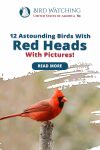
What’s This Post About?
Bird watching is a great leisure activity enjoyed by many people. It gives us a break from the chaotic world and brings us closer to nature. The entire process of the birds flying around the backyard is a pleasant sight.
If you become more aware of the birds that tour your yard, you’ll notice slight differences between the birds. You won’t always be able to distinguish based on color. No matter how frequent these little visitors get, it is difficult to identify them.
There are many birds with red heads. Some popular ones include House Finch, Purple Finch, Cassin’s Finch, Vermilion Flycatcher, Summer Tanager, Red-headed Woodpecker, Northern Cardinal, Pyrrhuloxia, Red Crossbill, Pine Grosbeak, Scarlet Tanager, Red-breasted Sapsucker and Common Redpoll.
Which Birds Have Red Heads?
Red is one of the most vivid and visible tones of all colors. Brighter coloration also indicates endurance and better fitness, and several species undergo seasonal changes to replace their colors close to mating season in the hopes to find the most attractive mate.
Do you also get curious every time a new type of bird with a redhead flies past you, wondering if it was the same?
Read below to find out about 13 astounding birds with redheads that are backyard friendly. Next time you see a redhead bird, you will know which one was it!
| Names | Scientific Names |
|---|---|
| House Finch | Haemorhous mexicanus |
| Purple Finch | Haemorhous purpureus |
| Cassin’s Finch | Haemorhous cassinii |
| Vermilion Flycatcher | Pyrocephalus rubinus |
| Summer Tanager | Piranga rubra |
| Red-headed Woodpecker | Melanerpes erythrocephalus |
| Northern Cardinal | Cardinalis cardinalis |
| Pyrrhuloxia | Cardinalis sinuatus |
| Red Crossbill | Loxia curvirostra |
| Pine Grosbeak | Pinicola enucleator |
| Scarlet Tanager | Piranga olivacea |
| Red-breasted Sapsucker | Sphyrapicus ruber |
| Common Redpoll | Acanthis flammea |
- Red Finches
The House Finch, Cassin’s Finch, and Purple Finch are closely related, particularly in terms of color. There are areas in Washington where you can see all three birds at the same feeder. The male more distinctly show colors, and all of the three male species have red plumage.
When the feeder is unexpectedly infiltrated by finches, most nature lovers experience a surge of excitement. Let’s help you differentiate between the three.
1. House Finch
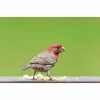
Between the three Finches, the House Finch will be most easily found. It is very easy to spot the male House Finch because it has a pale redhead, neck, and belly. The entire back and wings are both brown.
The female House Finch is brown and thus can be easily mistaken for any other bird. The head and the back are a darker shade of brown, while the neck, breast, underbelly, and wings have brown streaks. It doesn’t have any distinct feature, but you can identify them through their male counterparts.
Compared to the straight bills seen in the other two species, House Finches have longer tails and look sleeker overall. They also have noticeably rounded heads. To attract House Finches, equip your backyard with solid spaces so they can build a nest and also put out berries, seeds, and nectar.
2. Purple Finch
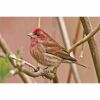
As the name suggests, the purple finch is more a mix of purple and red than just red like the House Finch. Apart from the shade, the distribution of the color is also quite different. While there is a subtle undertone of brown on the back, the bird is purple overall. It is has a distinct purple-red brown crown and the tail area that join through a white belly.
Again female Purple Finches are brown and white birds. These birds are streaked throughout the body with brown being more dominant on the back and white dominant on the belly.
These are not as widespread as the House Finches and can be found in areas of Washington primarily in winters as they move out of Canada. They will visit your feeders in winters if they aren’t dominated by other birds. They like lurking on branches of varying heights.
3. Cassin’s Finch
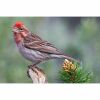
Cassin’s have a much more prominent face as compared to the House Finch. You can note a wing ring around the eye. The face and the crown are bright red while the area around it leads to the breast that is rosier. This is then joined by a white belly. There is also more dramatic brown streaking on the wings that leads to a threaded tail.
While Cassin’s Finches are common in eastern Washington, the number of them in any given area varies greatly from year to year. You will find them at higher locations as compared to the other two species.
4. Vermilion Flycatcher
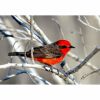
The vermilion flycatcher is a small bird with a length of 13–14 cm from beak to tail.
It has vibrant red fur from its forehead and crown to its underbelly. This is contrasted beautifully by a deep brown on its back, wings, and legs. Females are less brazen, but they do have a striking red wash on their underbelly.
So, if a vermilion flycatcher visits your backyard, it’s unlikely that you fail to spot it. It is found in areas of the southern United States and Mexico.
5. Summer Tanager
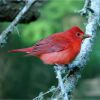
A summer tanager has a striking red color throughout its body. The back and the wings can have a darker toned red. A female summer tanager, however, has a vibrant yellow color without any streaks or combinations.
An immature summer tanager is a mix of male and female colors. As it develops one color starts to dominate until it takes over completely on reaching maturity. The amount of red can be used to signify the bird’s maturity.
In the summer, summer tanagers can be seen in northeastern and Midwest America, whereas these birds fly to warm climates of Central America and Mexico during the cold. You can spot them in the open spaces of pine-oak trees.
6. Red-headed Woodpecker
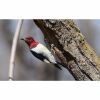
It’s amazing how these birds find a way to be distinct with so many similarities. Even with countless other birds having a red plumage, a red-headed woodpecker can be spotted easily.
It has a shiny redhead that goes down to the neck and throat. The rest of the body contrasts between black and white with the belly being completely white.
An immature red-headed woodpecker has a brown head that slowly develops into red with maturity. They start to develop mature colors around February.
Did You Know?
Unlike other species, a red-headed woodpecker has the same appearance whether male or female.
With their large beaks, they usually hunt for food in tree trunks or catch insects in the air. You will find them pecking away their food to store them in the tree trunks. It’s no wonder they are called woodpeckers. These strikingly visible birds can be found all over the eastern and central USA.
To attract a red-headed woodpecker:
- Deadwood can act as a very good attraction
- You can build a birdhouse for these visitors
- Place sunflower seeds in your feeders
7. Northern Cardinal
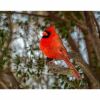
A northern cardinal is most easily identifiable through its red crest. The rest of the body is also a bright red except for the area around its thick bill. The area around the bill extending till the bird’s throat is black. It’s almost as if it were wearing a black face mask on its otherwise red body.
The female northern cardinal is a dull faded brown color. There are some red highlights on the crest and wings. It also has a similar red and thick bill as the male bird.
It is very common to find these delightful birds in yards all year round, especially around winters. They sit back in a hunched position with their tails pointing downward.
Did You Know?
The northern cardinal is also known as the state bird of Ohio.
8. Pyrrhuloxia
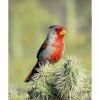
The pyrrhuloxia is also referred to as the desert cardinal because of its striking resemblance to the northern cardinal. The lively whistling is also identical to the northern cardinal.
The bird is grey overall but has a few specific red markings. It has red highlights on the crest, belly, and back. The female pyrrhuloxia is very similar except it has few red markings. The key feature, however, in both genders is the short yellow bill.
These species are usually found in sparsely populated, windblown environments in western and southern Texas.
9. Red Crossbill
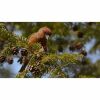
Overall, males are a rusty red or orange color. Gray or brown highlights can be seen on the wings. Females have a subdued olive-yellow color with no markings on their wings. The color of immatures is a combination of yellow and red.
As they get older, they acquire either the male or female tint. There are no wing bars on them. These birds are nomadic, particularly in the winter, and migrate well south of their usual range in certain cases. They travel in small flocks.
They can be seen in forests, cultivated green plains, or feeders in your backyard at this period. The Red Crossbill eats seeds from pine, hemlock, Douglas-fir, and spruce cones because they are high in nutrients.
Did You Know?
A red crossbill can split into closed cones, unlike other bird species, due to its unique-shaped bill.
10. Pine Grosbeak
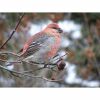
An adult male pine grosbeak has a pinkish-red head and body. There is a slight grey undertone on the back. Its wings are a darker shade of grey with two white wing bars. The female, an immature bird, almost looks identical. Instead of a redhead and rump, they are yellowish-orange.
With their large and pointy bill, they can quickly smash seeds and peck plant buds. They reproduce in clear pine trees, but they visit feeders in the snow, particularly in the East, where they sometimes migrate far outside of their usual range.
Pine Grosbeaks are plumper than the average finches that land in your backyard. They are also friendlier and will allow you to observe from up close.
Pro-Tip?
Shake your feeders before refilling them. Often old seeds form clumps and get lodged within the feeder. It is a good idea to expel them before adding a new feed.
11. Scarlet Tanager
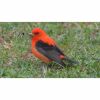
There is no way to confuse a beautiful scarlet tanager with any other bird. It has a bright red body from head to rump with jet black wings and a tail. A female scarlet tanager has a pale yellow body overall with grey wings and tail. Males exchange their crimson wings for yellow-green in the autumn, and the birds migrate to South America.
They’re also one of the most difficult to locate, as they sing from high in the treetops. You may be able to observe a burst of red when they go on a pursuit for an insect. Females with yellowish-green wings and dark wings can be much harder to find before you recognize the chick-burr sound.
Equip yourselves with these Noptix binoculars if you want to spot a scarlet tanager.
Noptix Binoculars
I recommend this Professional HD Quality Roof Prism Bird Watching Binoculars for Adults
Pro-Tip?
Scarlet Tanagers are berry-eating species. If you want to see more of these precious birds, be sure to stock up your backyard with all sorts of berry plants. It can be strawberries, blackberries, raspberries.
12. Red-breasted Sapsucker
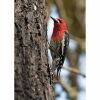
Just like a red-headed woodpecker, a red-breasted sapsucker has the same outlook for both genders. It has a redhead that merges into the white belly. There is a small white patch right in front of the eye. It has a black back and wings with a vertical white pattern on the shoulder.
They migrate to lowlands in winters where they may visit your backyards. Be sure to plant tall trees because they make nests within the bark and feed on the tree sap.
You can differentiate this from a red-headed woodpecker by two factors:
- The body of a red-headed woodpecker contrasts between black and white while the red-breasted sapsucker has a black back with white patterns.
- Sapsuckers create several tiny holes in straight lines. Woodpecker holes are bigger and are found all over the tree.
13. Common Redpoll
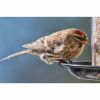
A common redpoll has a brown and white patterned small body. You will be able to spot a little red dot on the top of the head. The belly while white-colored has a pink tint to it. A female or immature common redpoll is very similar to the male in terms of brown and white streaking. There is no pink tint on the belly, just a red spot on its head.
Common redpolls can be spotted on feeders visiting your backyards in winter. You should, however, bear in mind that they travel in flocks that are constantly moving. You may likely miss them even if they did visit your feeder.
Keep Reading!
How different each species is regardless of their countless similarities is jaw-dropping. You cannot help but wonder about the divinity that lies within nature. It is not easy to identify birds even if you are a constant bird watcher.
There are many gorgeous birds with red heads including House Finch, Purple Finch, Cassin’s Finch, Vermilion Flycatcher, Summer Tanager, and more.
You will find more similarities with a different species than with a different gender of the same species. It is honestly very confusing. Your best bet is to keep yourself aware of the species most likely to visit your backyard and compare what you see with your knowledge.
Some people are perplexed as to how anyone can acquire experience in a species and quickly learn to recognize its characteristics. Bird watching is a relatively easy activity that requires slight technological knowledge. To learn how to start bird watching, read our blog and jump-start your bird watching journey.
How to Start Bird Watching? A Fantastic Guide for An Enthralling Experience!
Is the trend of birdwatching catching onto you? Are you looking to amplify your birdwatching experience? Don’t miss out on reading this fantastic guide.

By David A. Swanson
Bird Watching USA
My name is David and I'm the the founder of Bird Watching USA! I started Bird Watching with My father-in-law many years ago, and I've become an addict to watching these beautiful creatures. I've learnt so much over about bird watching over the years that I want to share with the world everything I know about them!

David A. Swanson
Bird Watching USA
My name is David and I'm the the founder of Bird Watching USA! I started Bird Watching with My father-in-law many years ago, and I've become an addict to watching these beautiful creatures. I've learnt so much over about bird watching over the years that I want to share with the world everything I know about them!




